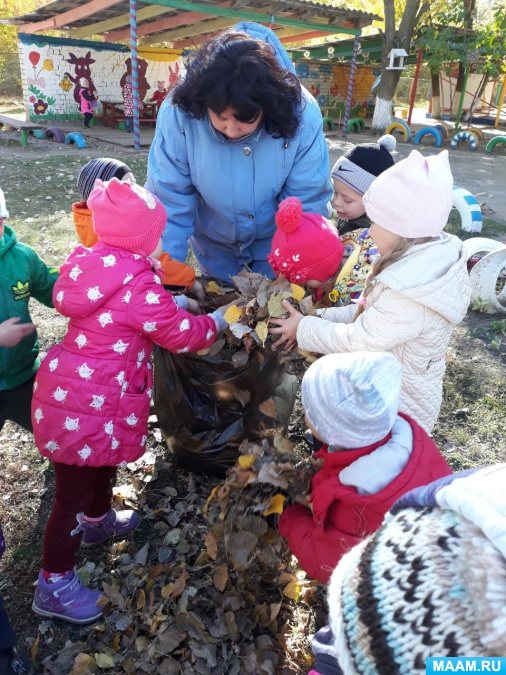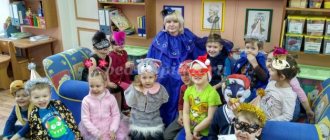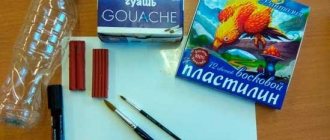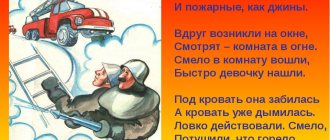What do children do in the fall? Freeze street treasures
If you have a suitable muffin tin that you don't mind using, you can play with icy street treasures.
You will need:
- muffin tin/large ice tray
- various objects found in a forest or park: pebbles, leaves, flowers, cones, etc.
- water
While walking, ask your child to find interesting objects: pine cones, acorns, some grass, pine needles, pebbles, shells, twigs, flowers or a handful of sand - everything that children usually happily put in their or their mother’s pockets and try to take with them . And at home, you can invite him to freeze all his “treasures” in a muffin tin or in a large ice tray.
Let the child himself put his finds into different cells, fill them with water (boiled so that the ice turns out transparent) and set them to freeze. And then, when everything is frozen, place the “ice cupcakes” on a tray or in a basin so that the child can see what he has done.
Did the color of the cones that were inside the ice change? How did the needles freeze? What happened to the stones? Take some small toys and create adventures with them. You can play, for example, how insects, in search of their favorite flowers or cones, ended up in an icy world - how their paws froze while they tried to get to the plants, and how they helped each other not to freeze. Or, on the contrary, you can try to melt everything as quickly as possible using a syringe, spray bottle or kettle with warm water.
On the topic: methodological developments, presentations and notes
calendar thematic planning in the senior group on the topic of People's Labor in the spring. Where did the bread come from?
Summary of organized educational activities in the senior group on the topic “People’s work in the spring.”
Educator, Yuryeva S. Ya. Summary of a conversation with children of the middle group on the topic “People’s work in the spring” Purpose: To clarify children’s knowledge about people’s work in the garden in the spring. Tasks: 1. Expand ideas about.
Goals: expanding ideas about the need and importance of adult labor. Formation of ideas about people’s work in the spring in the countryside. Expansion and activation of the dictionary on the topic “The work of spring people.
Lesson summary on the topic “People’s work in autumn.”
Introducing children to agricultural work, agricultural professions (grain grower, tractor driver, combine operator) and technology, expanding their understanding of the autumn harvest and the growing process.
Source
What kind of crop is harvested in the fall? Autumn work in the garden at the dacha: harvesting and tillage
The weather in September is still quite warm and allows you to collect the remaining harvest at the dacha. At the beginning of the month, potatoes are dug up, tomatoes, sweet peppers, and eggplants are collected. Then comes the turn of carrots and beets. At the end of the month they begin collecting zucchini, pumpkin and cabbage.
Dig it up in dry weather, otherwise wet tubers will not be stored well. Seed specimens are placed in the sun for several days so that they turn slightly green. Solanine formed in tubers is a toxic substance; it repels rodents, destroys fungal infections and allows you to preserve potatoes until spring. The rest of the harvest is removed immediately to storage rooms, since tubers that have turned green in the sun cannot be eaten.
Tomatoes must be removed from the bushes before the air temperature begins to drop below +5°C. If the fruits have not yet ripened, they are placed in a box, layered with paper towels, and covered with paper. The optimal air temperature for storage is 15 - 18°C.
A sign of ripening carrots is the yellowing of the tops and the appearance of hairs on the root crop. Only whole specimens are suitable for storage, so vegetables should be removed from the ground with caution. The tops are cut off immediately. Root vegetables are not washed, but only ventilated. For storage they are placed in boxes with sand or sawdust.
The best time to harvest beets is the second half of September. By this time, the root crops reach the desired size and accumulate a sufficient amount of useful substances, and the tops begin to fade. Vegetables without damage are selected for storage. The tops are not cut off completely, leaving about 1 cm. It is best to store beets together with potatoes.
To determine whether cabbage is ready for harvesting, you need to squeeze the head of cabbage. If it is elastic and does not press through, you can cut it off. The upper leaves are removed, leaving a stalk of approximately 2-3 cm. Small, dense heads of cabbage of light color are stored well.
After harvesting, the area is cleared of tops. It should be borne in mind that the tops of potatoes, tomatoes, cucumbers, peppers and eggplants are destroyed immediately. It cannot be used to further fertilize the soil in the form of compost. Closer to autumn, many leaves are affected by a disease such as late blight, and the ground may become contaminated.
Work on the site in the fall with middle school children!
Nadezhda Petrova
Work on the site in the fall with middle school children!
Labor education is one of the most important aspects of raising children.

In the fall , on a walk with the children , we watch the janitor at work. Children really like such observations, especially their interest in the observed work of adults when they can take at least a small part .
In kindergarten, labor education consists of familiarizing children with the work of adults , introducing children to the work activities .
Today, during an afternoon walk, the children of the middle group, under my leadership, took part in cleaning the area from autumn foliage .
The children enjoyed collecting fallen leaves in piles, and then we collected the leaves in bags and took them away from the site , collecting beautiful leaves for herbariums and decorating the group room .
The girls also collected flower seeds from the flower beds. To develop independence and accuracy, children used children's equipment - rakes, shovels and buckets.
Photo report “Work and observation in nature in autumn” Golden autumn has come into its own. Multi-colored paints and their shades amaze and delight with their extraordinary beauty. The beauty of autumn crowns.
Calendar-thematic planning in the middle group on the topic “People’s work in autumn” Day of the week mode Integration of educational areas Joint activities of adults and children, taking into account the integration of educational areas.
Calendar planning for the week “Adult Labor in Autumn” Planning of educational work for the 4th week of October 2022. Group: medium Topic of the month: Autumn Topic of the week: “.
Summary of a speech therapy lesson with children of the preparatory group with OHP “Autumn. Trees in autumn" Goal: Speech and cognitive development of children within the framework of work on the lexical topic "Autumn. Trees in autumn" Objectives: Correctional and educational:.
Summary of work activities with children of the middle group in the afternoon (household work) Washing toys and distributing them in place. Goal: to teach children to maintain cleanliness and order in the group room. Tasks: 1. accustom.
Open viewing of joint educational activities in the middle group “Labor on the site of a preschool educational institution” No. 5 “Stars” Observation of the work of a janitor Purpose: To promote the development in children of knowledge about the work of adults through structural components.
Plan of educational activities in the senior group “Nature of the native land”, “People’s work in autumn” Source for choosing topic No. 1: (Comprehensive thematic planning of preschool education, ways to motivate children to participate in activities: children will get to know each other.
Thematic week in the preparatory group with a compensatory focus “Vegetables. People's work in the garden in the fall" TOPIC: Vegetables. People's work in the garden in the fall. OBJECTIVES: To consolidate knowledge about the concept: vegetables. Teach children to differentiate the concepts of vegetables. Improve.
Source
Summary of the speech therapy lesson “Nature’s Pantry. People's work in autumn"
Tatyana Alferova
Summary of the speech therapy lesson “Nature’s Pantry. People's work in autumn"
Summary of a speech therapy lesson on the topic
" Nature's Pantry . People's work in autumn "
- practice guessing objects based on their description;
— develop mental activity based on establishing cause and effect relationships;
- develop children’s coherent speech;
— activate the dictionary of antonyms;
correctional and educational: to cultivate in children an interest in the environment, hygiene skills and proper nutrition skills.
Equipment: Top – Top, flipchart “Vegetable Garden”
(grandmother and grandfather in the garden; fairy tale
“Turnip”
,
“4 is the odd one out”
, models of vegetables in a basket, object pictures
(vegetables)
.




